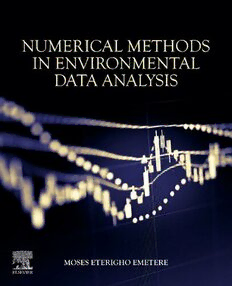
Numerical Methods in Environmental Data Analysis PDF
Preview Numerical Methods in Environmental Data Analysis
Numerical Methods in Environmental Data Analysis This page intentionally left blank Numerical Methods in Environmental Data Analysis Moses Eterigho Emetere Department of Mechanical Engineering Science, University of Johannesburg, South Africa Department of Physics, Covenant University, Ota, Ogun, Nigeria Elsevier Radarweg29,POBox211,1000AEAmsterdam,Netherlands TheBoulevard,LangfordLane,Kidlington,OxfordOX51GB,UnitedKingdom 50HampshireStreet,5thFloor,Cambridge,MA02139,UnitedStates Copyright©2022ElsevierInc.Allrightsreserved. Nopartofthispublicationmaybereproducedortransmittedinanyformorbyany means,electronicormechanical,includingphotocopying,recording,oranyinformation storageandretrievalsystem,withoutpermissioninwritingfromthepublisher.Detailson howtoseekpermission,furtherinformationaboutthePublisher’spermissionspolicies andourarrangementswithorganizationssuchastheCopyrightClearanceCenterandthe CopyrightLicensingAgency,canbefoundatourwebsite:www.elsevier.com/permissions. Thisbookandtheindividualcontributionscontainedinitareprotectedundercopyright bythePublisher(otherthanasmaybenotedherein). Notices Knowledgeandbestpracticeinthisfieldareconstantlychanging.Asnewresearchand experiencebroadenourunderstanding,changesinresearchmethods,professional practices,ormedicaltreatmentmaybecomenecessary. Practitionersandresearchersmustalwaysrelyontheirownexperienceandknowledgein evaluatingandusinganyinformation,methods,compounds,orexperimentsdescribed herein.Inusingsuchinformationormethodstheyshouldbemindfuloftheirownsafety andthesafetyofothers,includingpartiesforwhomtheyhaveaprofessionalresponsibility. Tothefullestextentofthelaw,neitherthePublishernortheauthors,contributors,or editors,assumeanyliabilityforanyinjuryand/ordamagetopersonsorpropertyasa matterofproductsliability,negligenceorotherwise,orfromanyuseoroperationofany methods,products,instructions,orideascontainedinthematerialherein. ISBN:978-0-12-818971-9 ForinformationonallElsevierpublicationsvisitourwebsiteat https://www.elsevier.com/books-and-journals Publisher:CandiceG.Janco AcquisitionsEditor:PeterLlewellyn EditorialProjectManager:AleksandraPackowska ProductionProjectManager:SreejithViswanathan CoverDesigner:MarkRogers TypesetbyTNQTechnologies Contents Preface..................................................................................................ix CHAPTER 1 Overview on data treatment.....................................1 1 Introduction........................................................................1 1.1 Mathematicaltechnique...................................................6 1.2 Computational technique..................................................7 1.3 Statistical data treatment..................................................7 References.............................................................................11 CHAPTER 2 Case study in environmental pollution research......13 1 Introduction.......................................................................13 1.1 Air pollution................................................................14 1.2 Land pollution..............................................................21 1.3 Waterpollution.............................................................24 1.4 Noise pollution.............................................................32 1.5 Radioactivepollution.....................................................33 1.6 Electronic waste pollution..............................................35 References.............................................................................38 Further reading.......................................................................39 CHAPTER 3 Typical environmental challenges...........................41 1 Introduction.......................................................................41 1.1 Thermal comfortasa source ofenvironmental concern.......41 1.2 Rainfallas asource ofenvironmentalconcern...................44 1.3 Recent environmental crisisand the problem ofclimate change........................................................................47 References.............................................................................51 CHAPTER 4 Generating environmental data: Progress and shortcoming...........................................................53 1 Method ofgenerating environmental data: common challenges, safety,and errors.................................................53 1.1 Data quality and errors..................................................55 1.2 Satellite measurement....................................................60 1.3 Modelingprocedure......................................................63 1.4 Experimental procedure.................................................69 2 Common errors in laboratory practice.....................................74 3 Maintaining laboratory apparatus...........................................75 References.............................................................................76 v vi Contents CHAPTER 5 Root finding technique in environmental research...79 1 Application of root finding technique toenvironmental data..................................................................................79 1.1 The root finding method.................................................79 1.2 Modification of the root finding method todata application...................................................................82 1.3 Computational application of root finding method to data application..........................................................103 Reference............................................................................117 CHAPTER 6 Numerical differential analysis in environmental research..............................................................119 1 Introduction.....................................................................119 1.1 Euler method.............................................................121 1.2 Improved Euler method...............................................122 1.3 RungeeKuttamethod..................................................123 1.4 PredictorCorrector method...........................................126 1.5 Midpointmethod........................................................128 1.6 Application of numerical methods ofsolving differentiationin environmental research.........................128 1.7 Computational processing of numerical methods for solvingdifferential equation.....................................136 1.8 Computational application of derivativesto environmentaldata......................................................142 1.9 Case 1:derivativeofexperimental data...........................142 References...........................................................................147 Further reading.....................................................................148 CHAPTER 7 Numerical integration application to environmental data..............................................149 1 Introduction.....................................................................149 1.1 Midpoint...................................................................149 1.2 Trapezoidal rule..........................................................151 1.3 Simpson’srule............................................................154 1.4 Computational application of numerical integration..........158 References...........................................................................168 CHAPTER 8 Numerical interpolation in environmental research..............................................................169 1 Introduction.....................................................................169 2 Application ofinterpolation toenvironmental data..................170 3 Lagrange interpolation.......................................................172 Contents vii 4 Newton interpolation.........................................................176 5 Spline interpolation...........................................................179 6 Computational application ofinterpolation............................181 References...........................................................................189 CHAPTER 9 Environmental/atmospheric numerical models formulations: model review..................................191 1 Introduction.....................................................................191 1.1 Global forecast system...............................................191 1.2 NOGAPS-ALPHA model...........................................192 1.3 Global Environmental Multiscale Model (GEM).............195 1.4 European Centerfor Medium Range Weather Forecasts...196 1.5 UnifiedModel (UKMO).............................................197 1.6 French global atmospheric forecastmodel(ARPEGE).....199 1.7 Weather Research and Forecasting (WRF).....................200 1.8 Japan Meteorological AgencyNonhydrostaticModel (JMA-NHM)............................................................203 1.9 Thefifth generation mesoscale model...........................205 1.10 Advanced RegionPrediction System (ARPS).................206 1.11 High Resolution Limited Area Model (HIRLAM)...........207 1.12 Global Environmental Multiscale limitedarea model......208 1.13 ALADIN model........................................................210 1.14 Eta model................................................................213 1.15 Microscale model(MIMO).........................................215 1.16 Regionalatmospheric modelingsystem (RAMS)............216 References...........................................................................217 Further reading.....................................................................221 Index...................................................................................................223 This page intentionally left blank Preface Environmental data may be described in terms of quantitative, qualitative, or geographically referenced facts that represent the state of the environment and its changes. Quantitative environmental data consist of data, statistics and indicators of databases, spreadsheets, compendia, and yearbook type products. Qualitative environment data are descriptions (e.g., textual, pictorial) of the environment or its constituent parts that cannot be adequately represented by accurate quantitative orgeographicallyreferenceddescriptors.Geographicallyreferencedenvironmental data are described in digital maps, satellite imagery, and other sources linked to a location or map feature. Summarily, it can be postulated that dataset in environ- mental studies is like blood to the human body. All decisions in environmental studiesarebasedonobservablesthataremeasurable,reliable,realistic,andconsis- tentwiththeories.Environmentaltheoriesareformulatedfromobservables.Hence, a faulty observable can lead to a colossal failure in processes, prediction, model formulation, and decision. Theinevitableoutcomesofclimatechangehaveredefinedobservablessuchthat newtheoriesandmodelsarenecessaryduetodatainconsistency,noise,andspikes. Asidefromjustgettingdatasetandsimulating,itisnowexpedientthattheintegrity ofadatasetbethefirstlineofoperationindataanalytics.Thisfeatcanbeachieved through the guidance of proven theories. The knowledge of this theory, when to apply it on a dataset, how to apply it, and ways to validate emerging results are salient in any field of environmental sciences. Hence, the focus of this book is to educate beginnersandprofessionals on the above. Environmental indicatorsare usually the environment statistics thatare inneed offurtherprocessingandinterpretation.Basedonthis,thereistheneedoftheappli- cation of numerical methods to validate, expatiate, predict, back-trace, and create new possibilities. Validation technique through numerical methods enables the researcher to ascertain the pattern trend of series of observables and tie them to certain established theories. Expatiation technique through numerical methods enables the researcher to take an informed numerical guess to replace missing data, noise, and data anomalies. Missing data is common in atmospheric research. Missing data makes the genuity of the data to be questionable especially when theuserisabeginnerornovice.Assumeifthesatellitemeasurementofaparameter showsmissingvaluesfor7monthsinayearlydataset.Ignoringthemissingdatafor theremaining5monthswouldcertainlybeerroneoustoanalyzemonthlyorseason- ally.Thesamescenarioappliestonoiseindataanddataanomalies.Thisbookseeks totrain beginnersandprofessionals on the aforementioned expertise. ix
